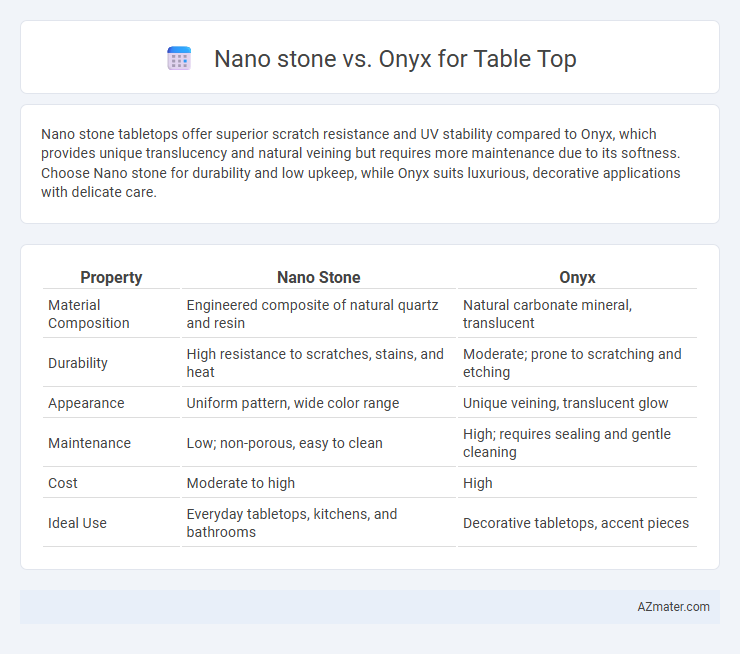Nano stone tabletops offer superior scratch resistance and UV stability compared to Onyx, which provides unique translucency and natural veining but requires more maintenance due to its softness. Choose Nano stone for durability and low upkeep, while Onyx suits luxurious, decorative applications with delicate care.
Table of Comparison
| Property | Nano Stone | Onyx |
|---|---|---|
| Material Composition | Engineered composite of natural quartz and resin | Natural carbonate mineral, translucent |
| Durability | High resistance to scratches, stains, and heat | Moderate; prone to scratching and etching |
| Appearance | Uniform pattern, wide color range | Unique veining, translucent glow |
| Maintenance | Low; non-porous, easy to clean | High; requires sealing and gentle cleaning |
| Cost | Moderate to high | High |
| Ideal Use | Everyday tabletops, kitchens, and bathrooms | Decorative tabletops, accent pieces |
Introduction to Nano Stone and Onyx
Nano stone is a highly durable, non-porous engineered surface composed of natural minerals and resin, ideal for table tops due to its resistance to scratches and stains. Onyx, a natural stone known for its translucent veining and luxurious appearance, offers unique aesthetic appeal but requires more maintenance and is prone to scratching and etching. Comparing nano stone and onyx for table tops highlights the balance between nano stone's enhanced durability and onyx's distinctive elegance.
Composition and Material Properties
Nano stone tabletops consist of engineered quartz combined with resin, offering enhanced durability and resistance to scratches, stains, and heat. Onyx is a natural stone composed primarily of calcite or aragonite, known for its translucent beauty but greater fragility and susceptibility to acid etching and scratches. Nano stone provides consistent material properties and low maintenance, while onyx requires careful handling and sealing to preserve its delicate surface.
Aesthetic Appeal: Colors and Patterns
Nano stone offers a wide range of vibrant, consistent colors and subtle patterns that create a sleek, modern look for table tops. Onyx is prized for its unique, natural veining and translucent qualities that add depth and luxurious elegance. Both materials provide distinct aesthetic appeal, with nano stone emphasizing uniformity and durability, while onyx highlights organic beauty and sophistication.
Durability and Strength Comparison
Nano stone tabletops offer exceptional durability with high resistance to scratches, stains, and heat, making them ideal for heavy daily use. Onyx, while aesthetically striking with its translucent and unique veining, is softer and more prone to scratching and chipping under impact. The superior strength of nano stone ensures longer-lasting performance and less maintenance compared to the more delicate nature of onyx surfaces.
Maintenance and Cleaning Requirements
Nano stone tabletops offer exceptional durability with minimal maintenance, requiring only mild soap and water for cleaning and resisting stains and scratches effectively. Onyx tabletops demand more meticulous care, needing specialized stone cleaners and frequent sealing to prevent etching, staining, and surface damage due to their softer, porous nature. Regular upkeep for onyx includes avoiding acidic substances and abrasives, whereas nano stone surfaces tolerate everyday cleaning products and maintain their aesthetic appeal longer.
Cost Differences: Nano Stone vs Onyx
Nano stone tabletops typically cost between $40 to $70 per square foot, offering a more affordable option compared to onyx, which ranges from $70 to $150 per square foot due to its rarity and unique veining. Onyx's premium price reflects its natural translucency and luxurious aesthetic, often requiring more careful maintenance and installation, increasing overall expenses. Nano stone provides a durable, low-maintenance surface at a lower price point, making it a cost-effective alternative to onyx for high-end table tops.
Suitability for Various Design Styles
Nano stone offers exceptional durability and a sleek, modern aesthetic, making it highly suitable for minimalist and contemporary table tops. Onyx provides a luxurious, translucent quality with rich veining patterns, ideal for classic, elegant, and statement piece designs. Both materials adapt to various interior styles, but nano stone excels in high-traffic, modern environments, while onyx suits decorative, low-usage tabletops where visual impact is prioritized.
Environmental Impact and Sustainability
Nano stone tabletops offer enhanced sustainability due to their use of abundant natural minerals and energy-efficient manufacturing processes that reduce carbon emissions. Onyx, while prized for its unique translucency, often involves more intensive quarrying methods that negatively impact ecosystems and generate higher waste. Choosing nano stone supports eco-friendly interior design by minimizing environmental degradation and promoting resource conservation.
Application Versatility for Table Tops
Nano stone offers exceptional durability and scratch resistance, making it highly suitable for both indoor and outdoor table tops that endure heavy use. Onyx, while prized for its unique translucency and luxurious appearance, is softer and more prone to scratching, limiting its application primarily to decorative indoor table tops with lower traffic. The versatility of nano stone extends across modern, minimalist, and rustic styles, providing consistent performance and aesthetics, whereas onyx is best reserved for statement pieces where its delicate nature can be preserved.
Final Verdict: Which Is Better for Table Tops?
Nano stone offers superior durability and scratch resistance, making it ideal for high-traffic table tops exposed to daily wear and tear. Onyx provides unmatched aesthetic appeal with its translucent beauty and unique veining, yet it requires more careful maintenance due to its softness and susceptibility to damage. For practical use, nano stone is generally better suited for table tops demanding longevity and low upkeep, while onyx suits decorative pieces where visual impact is prioritized over durability.

Infographic: Nano stone vs Onyx for Table Top
 azmater.com
azmater.com